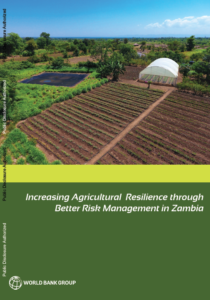
April 2018 – The World Bank published a comprehensive study report "Increasing Agricultural Resilience through Better Risk Management in Zambia" to present the principal risks in Zambia's agricultural sector and the pathways for risk management. In preparing this report, the World Bank coordinated with PARM to ensure the integration of key outcomes into the PARM Process in Zambia.
According to the World Bank, Zambia’s agricultural sector contribution to GDP dropped from 8.2% between the years of 2011 and 2015 to 5.3% in 2015. This decline is attributable to the diverse risks affecting crops and livestock production and marketing activities at various levels.
In order to provide solutions to better manage risks in Zambia’s agricultural sector, a team of World Bank expert finalised the agricultural sector risk assessment early this year. The study recognises the compounded nature of risk and the multidimensional issues at play in managing agricultural risks. It adopts a mixed-method approach combining qualitative analysis of the enabling environment risk with quantification of production and trade risks. It also relied on stakeholders consultations and literature reviews to validate the key findings. A follow-up workshop was organised in Chisamba District to discuss and address gaps in risk management.
The analysis was based on risks affecting the top 10 agricultural commodities that together makeup about 80% of the value of farm production in Zambia. These are beef, maize, sugarcane, cassava, tobacco, cotton, groundnuts, vegetables, chicken, and pork.
The findings suggest that drought is the most important risk hindering agricultural production related activities, followed by excess rain and floods, and pests and diseases. On the average, severe drought events were found to occur once every 20 years, whereas smaller localised droughts occur once every 5 years. The worst drought took place in 1992 and led to crop losses worth $154 million. Drought events affect all commodities except cassava and cotton.
The study also reveals the most significant market risk affecting farmers and other actors in the value chain is price volatility resulting from the rapid effects of international price fluctuations. In addition, the introduction of the export ban leads to large carryover stock of maize and impacts the supply rate and farm-gate prices.
In terms of enabling environment risks, the study analysed key macroeconomic policies of 1983 and 2015. It revealed that the Structural Adjustment Program of the late 1980s and early 1990s, together with the disbandment policy on input and marketing subsidies and the privatization of parastatals adversely impacted on Zambia’s agricultural GDP. Similarly, civil service retrenchment during the period affected access to agricultural advisory services for various commodity chains. The study recognised however that, a precise quantification of losses from these policies can hardly be achieved given the unpredictable changes in the country’s macroeconomy, including dramatic fluctuations in the inflation rate and exchange rates.
The study also relied on risk prioritization exercises with stakeholder to identify management options for specific agricultural risks. The exercises proposed a myriad of options, including early warning systems, climate-smart farming, Zambia Commodity Exchange (ZAMACE) and warehouse receipt systems, safety net programs, agricultural diversification among others.
Considering the multiplicity of risk management options and the potential for cooperation in the implementation and planning, the study recommends the Government of Zambia and other stakeholders to prioritize three options in their agricultural risk management investment strategies; 1) early warning system for food security, 2) climate-smart agriculture and resilience through diversification, and 3) ZAMACE for a shock-responsive safety net.
This report has informed PARM’s decision to launch feasibility studies for investment into two potential agricultural market risks management tools. The first, Warehouse Receipt Systems (WRS) connected to the Food Reserve Agency and the Zambia Commodity Exchange (ZAMACE), and the second on Access to Information on Early Warning Systems.
